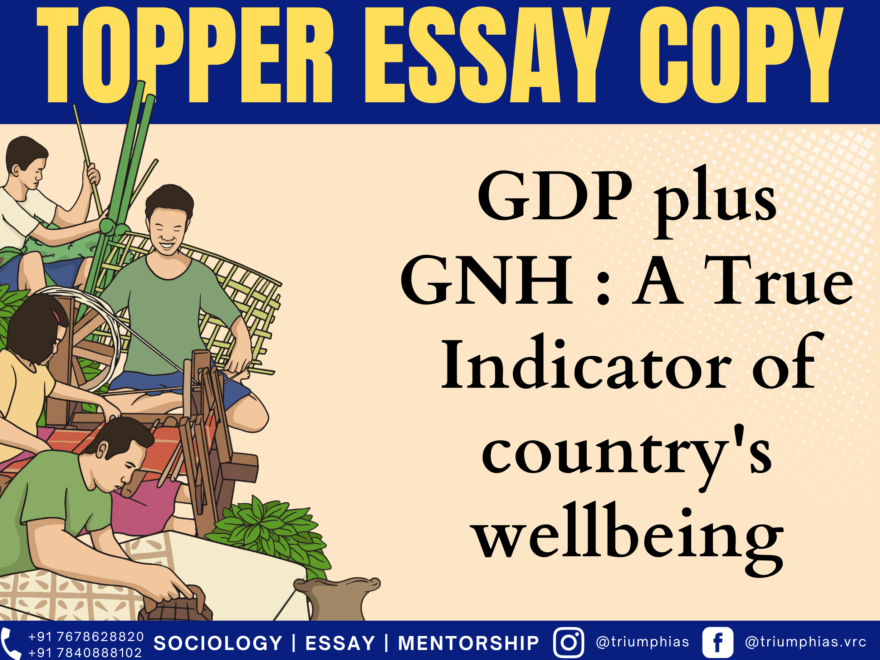Aashima Goyal

Essay Topic:
GDP plus GNH : A True Indicator of country’s wellbeing
(Relevant for Essay Writing for UPSC Civil Services Examination)
GDP plus GNH : A True Indicator of country’s wellbeing
The answer is no. GDP fails to give a comprehensive view of a country’s progress, happiness, and internal stability. This raises us to a new question of what can be a good parameter candidate to support and supplement GDP in understanding the well-being of a Nation. Gross National Happiness (GNH) has been suggested by many economists as a probable alternative. In this essay, we would first try to look at the meaning of GDP and GNH. We will then try to understand why there is an inevitable need to incorporate GNH in a country’s calculation of well-being. Further, what policy measures need to be taken to implement the same. GDP and GNH: THE TWO GOVERNING PARAMETERSGross domestic product (GDP) is defined as the measure of total output or production done within the territory of a country. Across countries, this is utilized as a primary parameter for measuring a country’s economic progress and comparing national economies on a global scale. Gross National Happiness (GNH) is a measure of total happiness of people residing in the country. This is a parameter reflecting the other perspectives of an individual’s life apart from monetary ones, those being meaningful living, access to resources, equitability and freedom of choice, among many others. GDP Without GNH – Growth without Happiness: WHAT ARE WE MISSING?Measuring only GDP and not GNH, is equivalent to being unilaterally focused on growth, ignoring grassroots development. The debate of GDP and GNH is similar to the debate of growth and development, wealth and inequalities, income, health and education. This is for the same reason that Amartya Sen describes capabilities to have basic necessities of life as meaningful human development. UNDP’S Human Development Index (HDI), which captures not only income but health and education parameters also, strives to give attention to the importance of measuring GNH. India’s service industry is booming, contributing an impressive percentage of 57% to the GDP of the country. But does GDP capture the agony and suffering of millions of farmers who fail to make both ends meet each day? Does GDP capture the effects of an absent or poor manufacturing base which renders millions of youth either jobless or employed in informal sectors devoid of any social security, at the mercy of employers? GDP fails to capture the inner nuances of the economy. This calls for the inclusion of GNH to ascertain a country’s well-being. India has earned a respectable status for being one of the largest producers of food grains. We have achieved self-sufficiency in food production. But we still linger in tackling the challenges of child undernourishment, stunting, currently at 35%, and wasting, currently at 21%. A unidimensional focus on GDP as a parameter of progress is responsible, to some extent. This again calls for the inclusion of GNH for measuring the true progress of a country. The skewed availability of resources, regional, sectoral disparities that GDP fails to capture, necessitate the incorporation of GNH. The top 1% of Indians own 70% of the wealth, the top 10% earn 56% of the income, but this is rarely reflected in GDP. The plight of manual scavengers who struggle to make a dignified place in society, beggars, tribals facing social exploitation and ostracization is overlooked when we capture only GDP and not GNH. A comparative analysis with Nordic countries further facilitates the argument in favour of GNH. Denmark, Sweden, Finland perpetually appear at the top of diverse rankings, be it freedom of the press, Global Peace Index, quality of air. It is the result of giving equal importance to increasing the happiness level of the people of their countries, that keeps them at the top. The learning is that happiness can’t be ignored for growth. One also should emphasize the positive relationship between GDP and GNH. Measuring GNH aims to target the happiness of people in terms of making accessibility to resources, freedom of various kinds, facilitating social mobility and a dignified living. This will further amplify in initiating a virtuous cycle where overall productivity of the community will go up, further pushing up GDP. But this time, it will be inclusive, embodying the ideal of “Sabka Sath, Sabka Vikas.” Initiating A Change: Happiness As a PARAMOUNT FACTORThus, the inclusion of GNH along with GDP is inevitable. The government should make efforts at materializing the idea into reality. We can learn from the neighbouring country, Bhutan. Bhutan has garnered global attention by having the highest happiness index. A close look at the parameters used for calculating happiness, the method of survey and data collection can help get a push start in measuring GNH along with GDP. Targeted approach for GNH should be taken in a way similar to the way taken for GDP on a year-by-year basis. This will not only instill enthusiasm in people but in the bureaucrats, governance machinery and politicians at large. CONCLUSIONWhile framing our constitution, the constitution makers not only kept the idea of economic growth at the centre of their hearts, but it was the ideas of social justice and political liberation also that were equally cherished by them. This is reflected in the preamble, the Directive Principles of State Policy and the very “fundamental” rights of people. These being the right to equality (Art 14), right against exploitation (Art 15), right to freedom of speech (Art 19), right to a dignified living (Art 21). Moving from GDP to GNH is a step to achieving these ideals. As somebody said, first you measure, then only you act! |
To master these intricacies and fare well in the Sociology Optional Syllabus, aspiring sociologists might benefit from guidance by the Best Sociology Optional Teacher and participation in the Best Sociology Optional Coaching. These avenues provide comprehensive assistance, ensuring a solid understanding of sociology’s diverse methodologies and techniques
Meta Tags:
Urbanisation, Blessing, Disguise, Economic Growth, Cultural Diversity, Environmental Challenges, India, Social Inclusion, Sustainable Development, SDG Goals, Urbanization is a blessing in disguise, Laxman Tiwari, Laxman Tiwari upsc, Laxman Tiwari CSE, Laxman Tiwari Essay copy, Laxman Tiwari Essay test copy

Why Vikash Ranjan’s foundation Classes for Essay?
Proper guidance and assistance are required to learn the skill of writing essay topics in CSE examination. VIKASH RANJAN SIR at TRIUMPH IAS guides students according to the Recent Trends of UPSC, making him the Best Essay Teacher for Essay writing UPSC.
At Triumph IAS, the Best Essay Writing Coaching platform, we not only provide the best study material and applied classes of Essay for IAS but also conduct regular assignments and class tests to assess candidates’ writing skills and understanding of the subject.
Choose The Best Essay Writing Teacher for IAS Preparation and Know our Approach for Essay?
- The Programme is Planned & Executed in a Way that You Write a good Essay for obtaining Effective Score of 140 Plus.
- In this programme we provide Classes on
- How to INTRODUCE The Topic in Context of the THEME of the Essay
- How to Elaborate & Explain the Topic-Theme on Temporal Scale & Sectoral Scale as well as Intellectual Scale in the MAIN BODY of the Essay.
- How to Sum up the Topic in CONCLUSION in Context of the Essay Topic Theme.
- ︎We will Teach You How to use the Knowledge Matrix of General Studies & Optional to write a Good Essay more Logically and Coherently.
- After the Classes You have to “Write to Learn & Learn to Score” .This means You have to Write the Essay Test Papers & Learn from the Feedback & Discussions.
Why Essay is Important and What We Offer in “Essay Test Series”?
- Triumph’s Essay Upgradation Test Series (Under Personal Guidance of Vikash Ranjan Sir) doesn’t only focus on improving student’s linguistic skills but also focus on improving student’s ability to comprehend the topic-sentence (subject) recall & relate the facts, concepts, propose thesis-statements, and logically assimilate the ideas & counter ideas with clarity in expression on temporal & Sectoral Scales of knowledge.
- Further students are provided one-on-one INTERACTION* Session with Vikash Ranjan Sir. Students get personal feedback on their strength and weaknesses, regarding what is ‘good about their essay and what more should be done to make it a better one’ by Vikash Ranjan Sir.
Why to take up this “Essay Test Series and Foundation” Course?
- Essay is Low hanging Fruit. Marks in Essay is Effectively Contributing in Final Selection in New Pattern of Mains Exam. With a Well Developed ‘Knowledge Matrix and Rigorous Practice’, One can Score upto 160 + in Essay. So IAS Aspirants should never Ignore Essay Preparation
- Inculcating Writing Competency in Essay for IAS, which is Different from Essay in English, Essay in School and College.
Follow us :
🔎 https://www.instagram.com/triumphias
🔎https://www.youtube.com/c/TriumphIAS
🔎https://t.me/VikashRanjanSociology
Find More Blogs…
| Compare and contrast Karl Marx’s and Max weber’s | Karl Marx- Historical Materialism |
| Position of Women In the Modern Indian Society | Sociology: Social system and pattern variables |
keyword: GDP plus GNH, GDP plus GNH, GDP plus GNH, GDP plus GNH, GDP plus GNH, GDP plus GNH GDP plus GNH GDP plus GNH, GDP plus GNH GDP plus GNH GDP plus GNH GDP plus GNH, GDP plus GNH, GDP plus GNH GDP plus GNH GDP plus GNH GDP plus GNH GDP plus GNH GDP plus GNH,GDP plus GNH, GDP plus GNH, GDP plus GNH, GDP plus GNH, GDP plus GNH, GDP plus GNH, GDP plus GNH, GDP plus GNH


